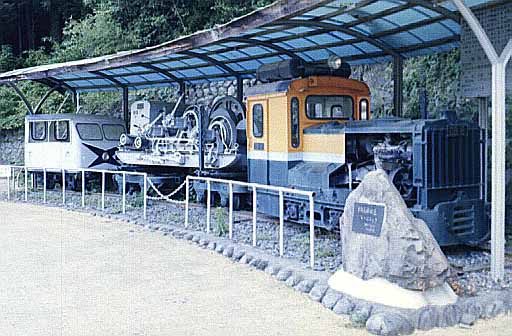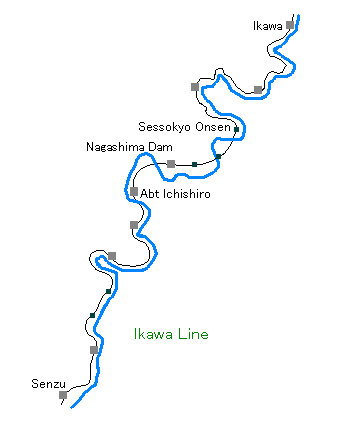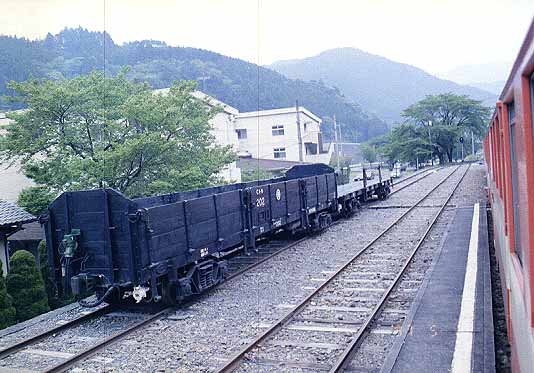

at Ikawa station.
exhibition at Senzu station.
Japan's most popular railfan destination with steam operations and an Abt rack rail system
 |
 |
|
A mini train at Ikawa station. |
An old logging train in exhibition at Senzu station. |
The Ikawa Line and Its History:
From Senzu, the Ikawa line starts its route. Although the line uses the
same 3'6'' gauge as the Oigawa main line's, the rolling stock in use is much
smaller in size than regular 3'6'' trains. The line is even called a forest
railway by local people and tourists. The reason for this peculiarity is
simple. The line was originally built by the electric power company in 1933
as a 2'6'' narrow gauge line with the main purpose of transporting
construction materials for dams and hydroelectric power plants. The line
later was transferred to the Forestry Ministry and was utilized as a logging
railway followed by extensions along tributary rivers in the depths of the
mountain range. The total trackage once accounted for even 50km at its
greatest. In 1936, to increase logging transportation capacity by allowing
dangerous rafts to be eliminated, the main line was regauged to
3'6''(1,067mm) enabling direct freight train operations through to the Oigawa
Railway line from Kanaya to Ikawa. To allow rapid progress and to reduce the
reconstruction costs, only the gauge of the track was widened and the
tunnels were not expanded in size. Thus, the line's allowable clearance
remained smaller and resulted in today's unique feature of the "mini" trains.
 After the war, as the projects of developing the Oi river water system
restarted, the construction of the Ikawa Dam was begun, and the mini
freight trains resumed busy operations. In 1951, the railway was taken over
by Chubu Denryoku, the electric power company based in central Japan,
which was constructing the Ikawa Dam. In 1958, the next year when
the Ikawa Dam was completed, the power company acquired the right to
operate the rail service on the line and commenced passenger revenue
operations. In 1959, the Oigawa Railway finally took over the entire trackage
of the Ikawa line. The construction of two huge dams, Hatanagi #1 and #2,
located upstream of the Ikawa Dam, was completed in 1964. The role of
transporting construction materials finally ended. Besides, as the
improvement of the roads made considerable progress, trucks the most became
common mode for log transportation, resulting in a sharp reduction on rail
freight demands. Under these circumstances, the railway company moved on to
enhancing passenger train service targeting tourists campaigning for a scenic
mountain railway going along a breathtaking deep canyon.
After the war, as the projects of developing the Oi river water system
restarted, the construction of the Ikawa Dam was begun, and the mini
freight trains resumed busy operations. In 1951, the railway was taken over
by Chubu Denryoku, the electric power company based in central Japan,
which was constructing the Ikawa Dam. In 1958, the next year when
the Ikawa Dam was completed, the power company acquired the right to
operate the rail service on the line and commenced passenger revenue
operations. In 1959, the Oigawa Railway finally took over the entire trackage
of the Ikawa line. The construction of two huge dams, Hatanagi #1 and #2,
located upstream of the Ikawa Dam, was completed in 1964. The role of
transporting construction materials finally ended. Besides, as the
improvement of the roads made considerable progress, trucks the most became
common mode for log transportation, resulting in a sharp reduction on rail
freight demands. Under these circumstances, the railway company moved on to
enhancing passenger train service targeting tourists campaigning for a scenic
mountain railway going along a breathtaking deep canyon.
Train Ride on Ikawa Line:
I hurried to the Ikawa line track, on which a mini train in its red and
cream livery was waiting. Although the passenger facility is separated from
the Oigawa main line, the rails are linked to each other through a siding.
Almost all the passengers who got off the steam train seemed to change to the
mini train. The formation of the mini train was five coaches with motive
power provided by a diesel hydraulic engine at the lower end. At the upper end
was a car with a driving cab for reverse operations. Push-pull operation
using a single engine with a car with driving cab at the opposite end is
commonly seen on U.S. and Canadian commuter lines, but this is the only
line in Japan that features this mode.
 |
 |
| On the siding were some smaller-sized freight cars. |
The train slowly wound up along a path faithfully tracing sweeping curves on the slope |
 |
| An electric locomotive standing by for banking duties. |
 |
| The train slowly rolled along the steeply grading rack rail track, at its steepest at 9%. |
With the assistance of the ED90, the train started to roll. The engineer
was a young man who seemed to be dedicated to operation of such duties.
I realized that the driving cab car was fitted with two sets of control
for both a regular diesel engine and an electric locomotive. The train
slowly rolled along the steeply grading rack rail track, at its steepest at
9%. With 50kg rails on the heavily laid ballast, riding comfort was very
good. After about ten minutes running, the train finished climbing up the
incline and completed the rack rail section by reaching the next loop at
Nagashima Dam. Like Abt-Ichishiro, this location looked modern with some
powered switches and position-light dwarf signals protecting switching
operations in the vicinity. Soon the helper was released and went backwards
down to a siding.
Soon after leaving Nagashima-Dam, the construction site of the huge Nagashima
Dam came into view down at the right. The train was still rolling along the
newly constructed track that continued further beyond the construction
complex. The train crossed a fairly long viaduct, the Rainbow Bridge, having
an intermediate station in the middle. On an elevated terrain beside the
station was a rest house, which looked like a log house, looking down at the
track on the viaduct. After the lake is filled in, the area is supposed to be
scenic with water reflecting the green of the forest on the surface, but
under the viaduct was a still just a deep canyon.
 |
 |
| The construction site of the Nagashima Dam. |
The Oi river was seen far down the track at the bottom of the canyon. |
Upstream of the Ikwa Dam is Ikwa Lake, about 10km long from the north to the
south. The central area of Ikawa village (actually part of Shizuoka city)
is located on the western coast of the lake a further 4km north from
the station. At the northern end of the lake is another huge dam, Hatanagi
#1 Dam. A bus service is available connecting Hatanagi #1 Dam and
Shizuoka city via Ikawa village and Ikawa station, but operations are
limited.
Oigawa Railway Ikawa Line Photos